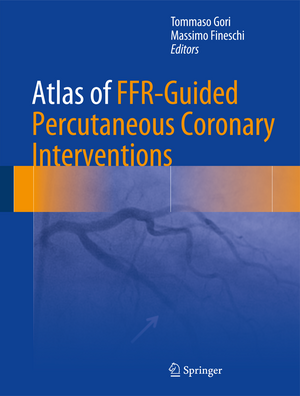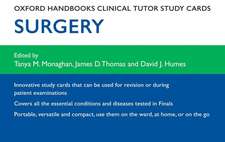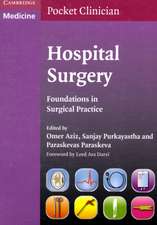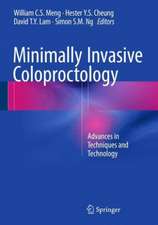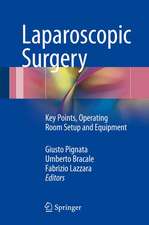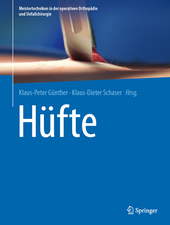Atlas of FFR-Guided Percutaneous Coronary Interventions
Editat de Tommaso Gori, Massimo Fineschien Limba Engleză Hardback – 18 ian 2017
This book reviews the theory and practice of fractional flow reserve (FFR)-guided coronary intervention, a technique that gives sense and a rationale to daily decisions in the interventional suite. FFR guidance provides detailed information on coronary hemodynamics for the interventional cardiologist. This technique has profound practical implications for therapeutic decisions and for the prognosis of patients.
The Atlas of FFR-Guided Percutaneous Coronary Interventions provides practicing physicians clear information to understand both the complexity of the technique and the correct way to apply it. It is designed both to assist younger faculty and those in training, and to act as a clinical resource for more experienced practitioners. Using the clinical cases outlined, the reader can learn to appreciate the pitfalls, tips and tricks that simplify the performance and interpretation of FFR and iFR.
The Atlas of FFR-Guided Percutaneous Coronary Interventions provides practicing physicians clear information to understand both the complexity of the technique and the correct way to apply it. It is designed both to assist younger faculty and those in training, and to act as a clinical resource for more experienced practitioners. Using the clinical cases outlined, the reader can learn to appreciate the pitfalls, tips and tricks that simplify the performance and interpretation of FFR and iFR.
| Toate formatele și edițiile | Preț | Express |
|---|---|---|
| Paperback (1) | 1268.54 lei 38-44 zile | |
| Springer International Publishing – 17 iul 2018 | 1268.54 lei 38-44 zile | |
| Hardback (1) | 1423.09 lei 38-44 zile | |
| Springer International Publishing – 18 ian 2017 | 1423.09 lei 38-44 zile |
Preț: 1423.09 lei
Preț vechi: 1497.98 lei
-5% Nou
Puncte Express: 2135
Preț estimativ în valută:
272.33€ • 282.60$ • 227.63£
272.33€ • 282.60$ • 227.63£
Carte tipărită la comandă
Livrare economică 11-17 martie
Preluare comenzi: 021 569.72.76
Specificații
ISBN-13: 9783319471143
ISBN-10: 3319471147
Pagini: 176
Ilustrații: XVI, 211 p. 136 illus., 104 illus. in color.
Dimensiuni: 210 x 279 x 18 mm
Greutate: 0.93 kg
Ediția:1st ed. 2016
Editura: Springer International Publishing
Colecția Springer
Locul publicării:Cham, Switzerland
ISBN-10: 3319471147
Pagini: 176
Ilustrații: XVI, 211 p. 136 illus., 104 illus. in color.
Dimensiuni: 210 x 279 x 18 mm
Greutate: 0.93 kg
Ediția:1st ed. 2016
Editura: Springer International Publishing
Colecția Springer
Locul publicării:Cham, Switzerland
Cuprins
Section I – Setting the Stage.- Setting the Stage: How To Perform FFR.- Section II – Clinical Cases.- Starting Easy: FFR in a High-Grade Stenosis.- Another Easy One: This Time in the Other Direction.- A False-Positive FFR.- A Negative FFR.- Reproducibility of the Result.- Decision-making in a Long Lesion: Full Metal Jacket or Spot Stenting?.- When the Pd/Pa Is Already Significant: A “Quick and Clean” FFR.- Contrast-induced Hyperemia and FFR: Slightly Slower But Still “Quick and Clean”.- Reproducibility of FFR.- Long-term Repeatability of FFR: Twin Measurements with Two Years In-between.- A Positive FFR in the Absence of Visible Stenosis: Where Is the Problem?.- Instant Wave-free Ratio Assessment.- Simplifying One’s Life: From Three-Vessel to One-Vessel Disease.-FFR to Determine Stent Length: When the Play Gets Tough.- Multiple Lesions, Multiple Measures.- Sequential Lesions and Bioresorbable Scaffolds.- FFR for a Lesion in the Left Main: None is So Blind As Those Who Will Not See.- Imaging of Ostial Lesions: How Reliable Is It?.- A Complex Left Main Disease.- Bifurcation Lesions: A Quicker Solution for Re-entry.- A Bifurcation with Surprise.- A Wire in Jail.- Mismatch Between Imaging and Functional Relevance of Coronary Stenoses: Seeing Is Not Believing.- FFR or IVUS for Small Vessels?.- Same IVUS, Same Vessel, Different FFR.- In-Stent Restenosis.- In-stent Restenosis with a Twist.- Using FFR to Detect Ischemia in Myocardial Bridge Lesions.- ACS–NSTEMI.- A Normal Fractional and Coronary Flow Reserve.- Impaired Fractional and Coronary Flow Reserve.- High-grade Epicardial Stenosis with Microvascular Compensation.- Threshold FFR, Impaired CFR, and IMR: Macrovascular or Microvascular Disease?.- Coronary Slow Flow in a Patient with Myocarditis.- A Complex Combination of Microvascular and MacrovascularDiseases.- The Impact of Venous Pressure on FFR: Do Diuretics Affect FFR?.- Decision-making in a Long Lesion: Full Metal Jacket or Spot Stenting?.- FFR in a Bypass.- Heart Failure: Really Idiopathic?
Notă biografică
Tommaso Gori MD is Director of the Heart Catheterization Laboratory at the Zentrum für Kardiologie in Mainz, Germany. He trained at the University of Siena, Italy and completed a PhD at the University of Toronto. He is a specialist in Internal Medicine and Cardiology, with particular research interests in endothelial (dys)function, mechanisms and effects of organic nitrates, physiology of the coronary circulation, oxidative stress, microcirculation and hemorheology, and clinical research interests in interventional cardiology and echocardiography.
Dr Gori is a winner of many international awards, including the American Heart Association S.A. Levine Young Investigator Award and American College of Cardiology Young Investigator Award, both in 2001. He is on the Editorial Boards of the European Heart Journal, World Heart Journal, and Clinical Hemorheology and Microcirculation. He has written numerous articles, textbook chapters and lectures and has extensive teaching experience at University Medical Center Mainz and University of Siena.
Massimo Fineschi MD is Medical Director of the Hemodynamics Unit at the University Hospital Santa Maria alle Scotte in Siena, Italy. He trained at the University of Siena, Italy, and completed his training in Cardiology in 1995 at the same institution.
His work has covered Elective and Urgent coronary angiography, Elective and Primary coronary angioplasty, Right and left heart catheterization and he has contributed to many research papers, and has spearheaded many trials.
Dr Gori is a winner of many international awards, including the American Heart Association S.A. Levine Young Investigator Award and American College of Cardiology Young Investigator Award, both in 2001. He is on the Editorial Boards of the European Heart Journal, World Heart Journal, and Clinical Hemorheology and Microcirculation. He has written numerous articles, textbook chapters and lectures and has extensive teaching experience at University Medical Center Mainz and University of Siena.
Massimo Fineschi MD is Medical Director of the Hemodynamics Unit at the University Hospital Santa Maria alle Scotte in Siena, Italy. He trained at the University of Siena, Italy, and completed his training in Cardiology in 1995 at the same institution.
His work has covered Elective and Urgent coronary angiography, Elective and Primary coronary angioplasty, Right and left heart catheterization and he has contributed to many research papers, and has spearheaded many trials.
Textul de pe ultima copertă
This book details the theory and practice of fractional flow reserve (FFR)-guided coronary intervention, a technique that, even with complex results, gives sense and a rationale to daily decisions in the interventional suite. FFR guidance provides detailed information on coronary hemodynamics for the interventional cardiologist. This technique has profound practical implications for therapeutic decisions and for the prognosis of patients.
This Atlas of FFR-Guided Percutaneous Coronary Interventions provides practicing physicians clear information to understand both the complexity of the technique and the correct way to apply it. It is designed both to assist younger faculty and those in training, and to act as a clinical resource for more experienced practitioners. Using the clinical cases outlined, the reader can learn to appreciate the pitfalls, tips and tricks that simplify the performance and interpretation of FFR and iFR.
This Atlas of FFR-Guided Percutaneous Coronary Interventions provides practicing physicians clear information to understand both the complexity of the technique and the correct way to apply it. It is designed both to assist younger faculty and those in training, and to act as a clinical resource for more experienced practitioners. Using the clinical cases outlined, the reader can learn to appreciate the pitfalls, tips and tricks that simplify the performance and interpretation of FFR and iFR.
Caracteristici
Incorporates FFR tracings from different cases (simple to complex ones) are presented alongside other multimodality assessments (IVUS, OCT) to integrate functional and anatomical information Represents an excellent image resource for FFR-guided percutaneous coronary interventions Provides in-depth clinical instruction for all learning about this technique
